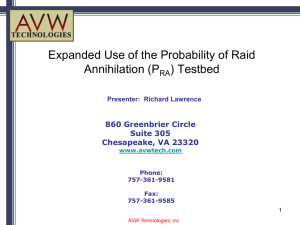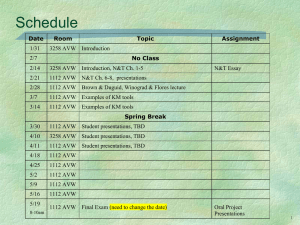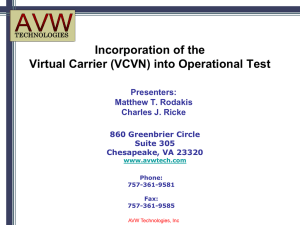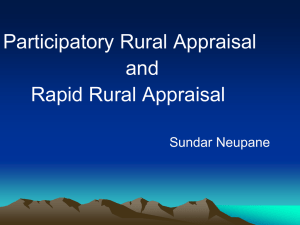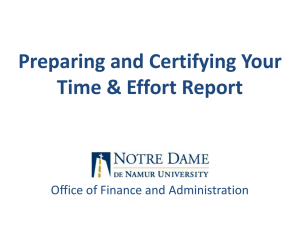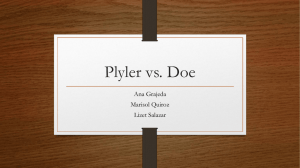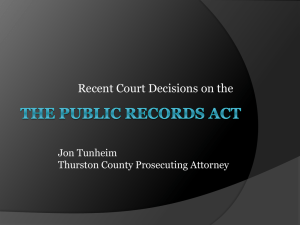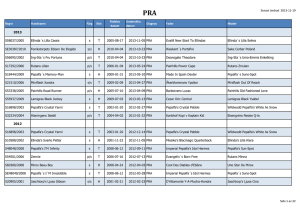DOE for PRA Testbed
advertisement
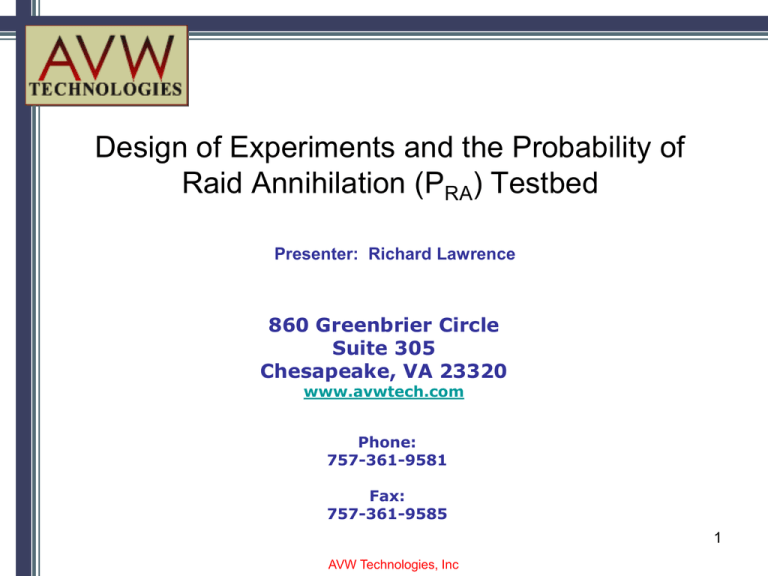
Design of Experiments and the Probability of Raid Annihilation (PRA) Testbed Presenter: Richard Lawrence 860 Greenbrier Circle Suite 305 Chesapeake, VA 23320 www.avwtech.com Phone: 757-361-9581 Fax: 757-361-9585 1 AVW Technologies, Inc Design of Experiments and PRA Testbed Introduction Design of Experiments (DOE) offers the opportunity for efficiency in test execution and to gain insight to the operations of complex systems. The current AAW SSD PRA metric is not DOE friendly in that the outputs of the Testbed do not lend themselves to straightforward statistical analysis. This is an overview of the challenges to executing a serious DOE process on the PRA Testbed and proposed methods to solve these challenges. Presentation Outline - Usable definition of DOE - Scoring - Background - Non-Determinism - Challenges - Basic Steps - Levels of Factors - Conclusion 2 AVW Technologies, Inc Principles of DOE • Create a statistical model of a system based on identified factors and measured outputs. • Purposefully vary input (factors) and correlate with outputs. X1 Y1 X2 Inputs X3 PROCESS Y2 Outputs X4 3 AVW Technologies, Inc Principles of DOE (2) • Run matrix is developed from several techniques to establish a ‘sample space’. • Different from ‘One Factor at a Time’ testing because variables are changed several at a time and effects are separated in the analysis phase. • Through analysis of outputs, identifies and quantifies effects of various factors Run X1 X2 X3 X4 1 + 0 0 5 2 - + + 2 3 - 0 + 2 Y1 Y2 Yave σY n 4 AVW Technologies, Inc Background • Current PRA methodology is: •Operationally relevant •Accepted and Established •Oriented solely to calculate a single value (PRA) •Ideal candidate for in-depth DOE T1R1 - sea-skimming, subsonic RF threat T2 - sea-skimming, subsonic Imaging IR threat Scenario “Clean” and “Dirty” Signatures AVW Technologies, Inc T5 - high diver, supersonic RF ARM threat T7 - sea-skimming, maneuvering supersonic Advanced RF Threat Littoral Scenario 5 Background and Challenges • Run Reduction Strategy for LPD 17 based on rudimentary application of DOE. • Historical analysis was attempted for LPD 17 data by AVW and DOT&E. • No surprising insights resulted • Lessons learned: •Categorized variables like radial are difficult to analyze, since they are not continuous. •Binary outcomes are even more difficult to analyze because there is no conventional way to calculate variance & other statistical parameters. • Necessitates a more in-depth approach to find confounding 6 factors and their interrelationships. AVW Technologies, Inc Additional Challenges • Difficult to identify ‘specific factors’ in particular scenarios •Requires runs to investigate • Each scenario (radial, TOD, etc.) has a confluence of factors • Example--different radials vary the following: • RF propagation for ship sensors (duct strength, height) • RF clutter for ship radars (land, wave direction) • Ship radar blockage • RF propagation for threat seeker • Ship RCS/Decoy effectiveness • IR scene for RAM • Wind • Threat spacing in bearing and distance 7 AVW Technologies, Inc Example: Environment Categorization • Empirical way to quantify input factors • Each radial would include a parameter for RF prop, clutter, IR scene, RCS, threat separation CNR vs. Range for 8 Radials from 20 to 335 Degrees True • Categorize each parameter: 100 20T 65T 110T 155T 220T 245T 290T 335T 80 • +1 favorable conditions 60 • 0 neutral conditions • -1 adverse conditions CNR (dB) 40 20 0 -20 -40 -60 -80 0 10 20 30 40 50 60 70 range (km) Ultimate goal is to eliminate test cases. 8 AVW Technologies, Inc Scoring • Analytical way to quantify outcomes • Miss distance • Aimpoint errors • Scoring related to ship (vulnerability) 9 AVW Technologies, Inc Non-Determinism • Demonstrated differing outcomes given identical scenarios during DT5. • Attributable to the way tactical software operates. • Is there a minimum number of trials required to give a statistically significant outcome? •Would require a large number of runs for each scenario OR • Treat each scenario as we do in real ships— any given event can go many different ways 10 AVW Technologies, Inc Basic Steps • Identify factors • Establish types and levels for each factor • Assign factor levels to each scenario • Identify, execute and analyze screening runs • Develop formalized run matrix • Execute runs • Analyze results • Refine formalized run matrix based on identified relevant factors 11 AVW Technologies, Inc Bottom Lines • DOE is a natural complement to ongoing V&V process • Gain value from Testbed runs during DTs (maximizing resource investment) • Analytical insight into Combat Systems performance and factors influencing engagement outcomes • Defendable approach to Testbed runs—to complement COTF’s methodology Test Analyze 12 AVW Technologies, Inc Design of Experiments and the Probability of Raid Annihilation (PRA) Testbed 860 Greenbrier Circle Suite 305 Chesapeake, VA 23320 www.avwtech.com Phone: 757-361-9581 Fax: 757-361-9585 13 AVW Technologies, Inc
